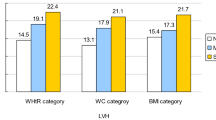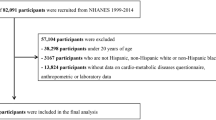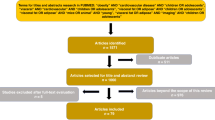Abstract
OBJECTIVE: To determine the relationship between cardiac size and various measures of adiposity in children and the occurrence of coronary fatty streaks in relation to childhood obesity. DESIGN: A retrospective study based on 210 medico-legal autopsies of 5–15 y old children who had suffered violent death in the Province of Oulu, Finland, in 1970–1995. METHODS: Autopsy reports with attached clinical data and police records were recovered from the archives of the Department of Forensic Medicine, University of Oulu, Finland. All 5–15 y old individuals who had died of external trauma and were not documented as having had any chronic illnesses were chosen for investigation. The following data were extracted from the papers: age, sex, height, body weight, heart weight, liver weight, total weight of the kidneys, thickness of the abdominal subcutaneous fat and description of the coronary arteries. Heart weight was indexed to height2.7, and liver weight and kidney weight were indexed to body weight, body surface area and height. The ponderal index (body weight/height3) was calculated, and relative body weight was determined as the percentage deviation of the weight from the mean weight for height according to a growth chart developed for Finnish children. RESULTS: The average absolute heart weight and heart weight/height2.7 were significantly higher in the boys than in the girls over 12 y of age. Abdominal subcutaneous fat was thicker in the girls, but there were no significant differences in the other indicators of obesity. After adjusting for age, there were significant positive correlations between the ponderal index and heart weight/height2.7 in both the boys (P=0.000) and the girls (P=0.038), between relative body weight and heart weight/height2.7 in the boys (P=0.000) and the girls (P=0.027), and between abdominal subcutaneous fat thickness and heart weight/height2.7 in the boys (P=0.045) but not in the girls (P=0.234). Multiple linear regression analysis showed the ponderal index to be a significant predictor of heart weight/height2.7. Coronary intimal fatty streaks were documented in six individuals (2.9%), five of them having a ponderal index above the average and all of them having a relative weight above the average. Kidney weights were higher in the boys and were positively correlated with the measures of obesity and with heart weight/height2.7. CONCLUSIONS: The results point to an important role of excess body weight and adiposity in the development of early myocardial and coronary changes in childhood: coronary fatty streaks were not found at all in the leanest individuals in this relatively large group and the cardiac size adjusted for body size indicated hypertrophy with increasing adiposity. Prospective autopsy studies are needed in order to determine whether adiposity and the regional distribution of fat, especially intra-abdominal fat accumulation, are associated with the earliest signs of myocardial hypertrophy and the initial phase of lesion development in the arterial intima of children.
This is a preview of subscription content, access via your institution
Access options
Subscribe to this journal
Receive 12 print issues and online access
$259.00 per year
only $21.58 per issue
Buy this article
- Purchase on Springer Link
- Instant access to full article PDF
Prices may be subject to local taxes which are calculated during checkout
Similar content being viewed by others
Author information
Authors and Affiliations
Rights and permissions
About this article
Cite this article
Kortelainen, ML. Adiposity, cardiac size and precursors of coronary atherosclerosis in 5 to 15-year-old children: a retrospective study of 210 violent deaths. Int J Obes 21, 691–697 (1997). https://doi.org/10.1038/sj.ijo.0800463
Received:
Revised:
Accepted:
Issue Date:
DOI: https://doi.org/10.1038/sj.ijo.0800463
Keywords
This article is cited by
-
Visceral fat and cardiometabolic future in children and adolescents: a critical update
Pediatric Research (2023)
-
Medical Management of Stable Coronary Atherosclerosis
Current Atherosclerosis Reports (2013)
-
FDG-PET is an effective imaging modality to detect and quantify age-related atherosclerosis in large arteries
European Journal of Nuclear Medicine and Molecular Imaging (2008)
-
Visceral fat and coronary pathology in male adolescents
International Journal of Obesity (2001)



